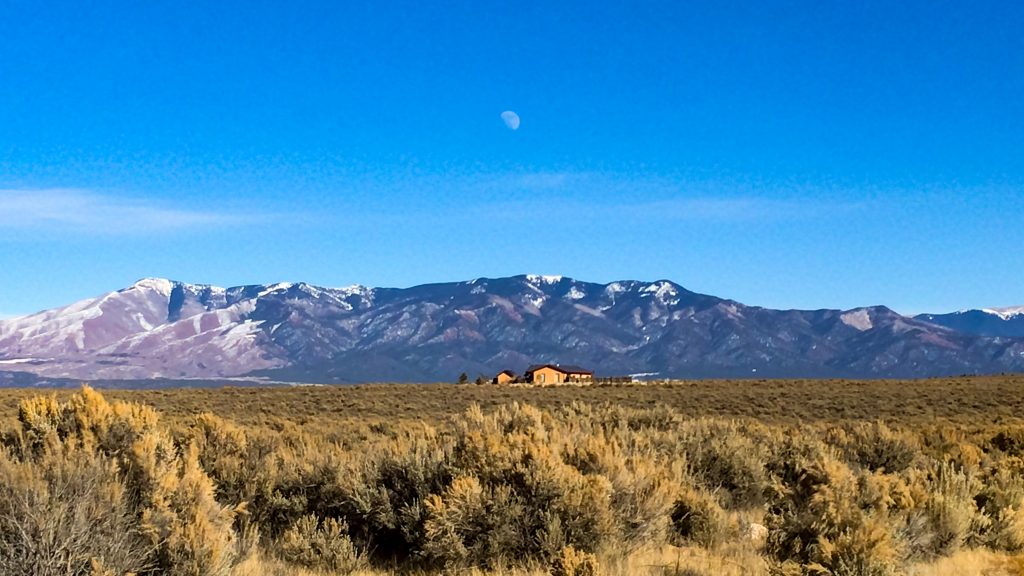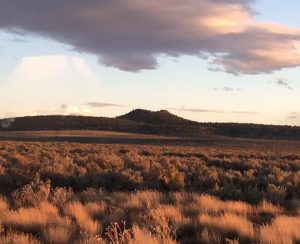Welcome to the Sagebrush Journal. In October 2017, we moved into an off-grid home with 20 acres on the Taos Mesa in northern New Mexico to escape the anthill that Denver, Colorado has become. This site is to journalize our new life.

Our home is in an area called the Taos Plateau or “the Mesa.” As the crow flies, we’re about halfway between Arroyo Hondo and Tres Piedras, New Mexico. It is somewhat confusing because our mailing address is in El Prado, which is the closest town by road, if you are going to Taos, and our street address is listed as Tres Piedras or Ojo Caliente, and even sometimes Carson. So we are in the middle of nowhere, halfway between everything.
The neigborhood is called Cielito Azul or just Cielito, which you could translate as “little blue heaven” or just “blue sky.” The nearest landmark is a old volcanic cone called Cerro de las Taoses, locally known as Two Peaks. When we describe where we live to locals, we say that “We’re out on the Mesa, just north of Two Peaks.”

The ecosystem is high-altitude desert or steppe. We are at about 7500 ft. above sea level. So we are hot in the summer and cold in the winter, and the prevailing wind from the southwest is constantly blowing. It is very arid, with only 10 to 14 inches of precipitation a year. The natural vegetation is big sagebrush with scattered broom snakeweed, blue grama, and widely scattered sand dropseed. There is an occasional, very widely scattered, pinyon pine or oneseed juniper. The soil quality is poor for agriculture and the basalt bedrock is only down about two feet. Wildlife that we’ve seen includes coyotes, hawks, jack-rabbits, cottontails, kangaroo mice, and tarantulas. Also there is a nearby ranch with free-range livestock including bison, yak, cattle, and llama, all of which occasionally escape the range and cross our property. Water is very deep, so digging a well is quite expensive. We have a share in a community well, but most of our water comes from roof catchment and is stored in two 3000 gallon underground cisterns. We also have aa 1000 gallon gray-water cistern for irrigation, although the gray-water system has been problematic and we have it temporarily bypassed.
We have an 1800 sq. ft. home with a 120 sq. ft. utility shed on 25 acres of wild sagebrush. The home is straw bale and stucco construction with a sloped metal pro-panel roof. It is, for the most part, passive solar heated with a supplemental catalytic wood stove. We also have seldom-used propane wall heaters in the bedrooms , and we use propane for the cooking stove and hot water heater.
We are three miles from the nearest paved road, NM Hwy 64, and about ten miles from the famous Rio Grande Gorge bridge. We have no electrical or wired communication services to our community. Our electrical is an off-grid solar panel and flooded battery system with about 17 Kwh of capacity. We can go about four to five days without sun before having to charge batteries with the back-up gas generator. Given that the sun shines here over 300 days a year, solar power is an ideal solution, with several advantages over wind. One of the most common questions we get asked is “What do you do for internet service?” Our current solution is an OTA microwave link, unfortunately it is only capable of 3Mbs download speed. At our former home, we had 100Mbs, so it is quite an adjustment. We can stream TV and movies to our Roku box, but just barely. We are considering whether HughesNet is worthwhile, given the high cost and lag issues. We also have spotty cell phone reception for cellular data service although we have to be careful to stay within our data limits.
Living off-grid and being 20 miles from the nearest grocery store is going to take some adjustment, but the wide open space, the wildlife, the 360 degree view, the spectacular sunrises and sunsets, and the peace and quiet all make this place, our little piece of heaven.